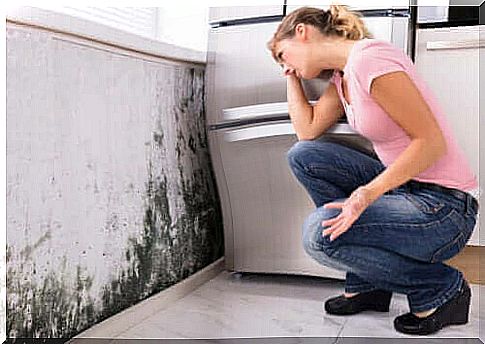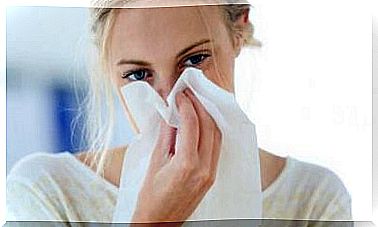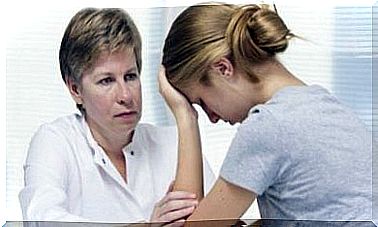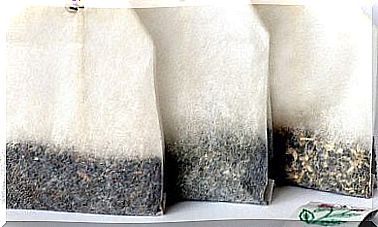Can Mold In The Home Lead To Health Problems?

The presence of mold in the home creates problems that can go beyond structural damage. The smell and stains on walls and ceilings are especially noticeable. This type of fungus can become the cause of various health problems in the long run.
According to information published by the US CDC ( Centers for DiseaseControl and Prevention) , exposure to damp and moldy environments leads to allergies and respiratory problems in some people. It can also trigger an attack in people with asthma.
What exactly is mold in the house?
As we mentioned above, this is a type of fungus that grows both indoors and outdoors. It usually appears in areas of high humidity, such as roofs or walls where water is leaking through windows and pipes. Mold also grows well any place where there is regular contact with moisture.
In addition, mold in the home grows well on cardboard elements, wood products, drywall, carpets and paint. The spores of mold spread easily through the air. In the right conditions, the fungus thrives.
It grows especially quickly when the environment is warm and humid. Checking your home for damp areas is essential to get rid of mold before it leads to health problems for the residents of the home.
According to an article in the journal Environmental Health Perspectives , there are about 500 species of fungi that are harmful to human health. The most common types of mold in the home are:
- Cladosporium
- Penicillium
- Aspergillus
Types of fungi

We don’t know exactly how many types of fungi there are in this world. Some suggest it may be 100,000, while others claim it is 300,000 or more. In any case, about 500 have been identified as potentially harmful to humans. The best known of these are:
- Alternaria belongs to the genus Ascomycete fungi and tends to develop in damp places in the house, such as the shower or under leaking sinks.
- Aspergillus is a fungus that can grow indoors, on fabric, on food or in building materials. It often leads to allergies and can even be toxic (English link) and lead to swelling of the airways and breathing problems.
- Cladosporium is a fungus that grows in both cold and warm regions. It is usually on fabric and wooden surfaces and also causes allergies.
- Penicillium has a blue or green surface and a velvety texture. It usually grows in buildings or houses that have been damaged by water, as well as in carpets, on wallpaper and in mattresses. The presence of this fungus in the house increases the risk of respiratory diseases.
- Acremonium is a fungal species with a characteristic pink, gray, orange or white hue. It usually grows in areas such as condensation from humidifiers, drain pans and window sealants. It is one of the most dangerous species and is associated with the development of bone marrow and immune system diseases.
How does mold get into the house?
Fungal spores are everywhere both indoors and outdoors, but are not visible to the naked eye. In either case, mold enters a home through:
- Windows
- open doors
- ventilation ducts
- air conditioning and heating systems
They can also stick to objects such as clothes and shoes. That way, the fungi will sneak into the house with the person wearing them. In addition, they often take a ride in a pet’s fur and enter your home that way.
The mold will grow if the right humidity conditions are in place in a home. If the conditions are not right, the fungus will not thrive and therefore cause no problems for the residents of the house.
Mold in the house and health problems
The presence of mold in the home is usually not a problem unless the spores come into contact with damp areas and start growing. There is a real health risk when this happens, especially if the occupants of a home have pre-existing respiratory or immune system disorders.
Possible allergies
Mold growth in the home can exacerbate the symptoms of anyone with allergies. In particular, mold causes annoying and persistent symptoms such as:
- a stuffy nose.
- itchy nose and throat.
- to sneeze.
- tearing eyes.
- excess mucus formation
Also, early exposure of children to mold or moisture appears to increase the risk of asthma and rhinitis. At least that is the conclusion of a study published in the journal Allergy .
Increased risk of respiratory disease

In addition to allergies, molds are also associated with other respiratory diseases. The research reported in the journal Environmental Health found that humidity and mold in the home significantly increase the risk of respiratory infections, such as bronchitis. This also applies to complaints such as:
- Hypersensitivity Pneumonitis
- Allergic Alveolitis
- Chronic Rhinosinusitis
- Sinusitis
- Lower respiratory problems in previously healthy children
Aspergillosis
Contact with the fungus Aspergillus can lead to a serious illness called aspergillosis. This can cause a serious infection that can even spread to other parts of the body. Aspergillosis is a serious lung disease that requires immediate medical attention.
Symptoms range from chronic cough to coughing and bleeding, fever, wheezing, and weight loss. This condition can also manifest with other complaints such as:
- bone pain
- Chestpain
- Chills
- A decrease in urine volume
- Headache (headache)
- Respiratory failure
- Visual impairment
- Skin lesions
How to prevent health problems caused by mold in your home
There are, of course, several measures to prevent the growth of mold in your home and thus prevent it from endangering your health. One of the most important measures is to ensure clean, well-ventilated and moisture-free areas.
In this regard, the Environmental Protection Agency (EPA) suggests looking for a humidity level below 60%. Other recommendations for preventing mold in the home include:
- Fix any leaks and remove any spilled water immediately.
- Install a dehumidifier to reduce indoor humidity.
- Open the windows for 15 minutes every day to allow the air to circulate.
- Install an extractor hood to absorb moisture while cooking.
- Do not dry clothes indoors.
- Empty and ventilate cupboards regularly, especially if you don’t use them often.
- Regularly clean all surfaces that are prone to mold, such as walls, ceilings, furniture, etc.
- Use anti-fungal products to disinfect the bathroom and other areas that are frequently exposed to moisture.
- Call a professional to troubleshoot structural problems that facilitate mold growth.
Consulting a doctor is important if there is mold in the house
Mold exposure does not always cause health problems. Still, preventing mold growth in your home is the best preventative measure to prevent problems.
Always see a doctor if you or any of your roommates have symptoms of allergies or breathing problems. You should not ignore these symptoms as they can lead to serious complications.
In addition, keep in mind that mold is not always the cause of a disease, but can aggravate other pre-existing conditions. That’s why you should follow a professional’s recommendations to resolve any moisture problems as quickly as possible.









